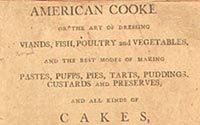When Did Americans Start Writing Cookbooks?
The tradition of American cooking goes back to early colonial times, when recipes were handed down by word of mouth and recorded in collections of handwritten "receipts" (meaning "received rules of cookery"). The few printed cookbooks in circulation in America during this period were European imports brought over by immigrant settlers. The first cookbook with an American imprint, Eliza Smith's The Complete Housewife, a reprint of a popular English work, would not appear until 1742, and the publication of the first cookbook by an American author, American Cookery by Amelia Simmons, would wait until 1796.
Although the printing of directions for food preparation has been a primary motive for their production since the colonial period, cookbooks or receipt books hold a larger historical significance. Since colonial times, the cookbook has reflected American progress and way of life. They reveal social customs, moralistic concerns, the foodstuffs available at a certain time, and progress in experimental cookery and nutritional research. Cookbooks, therefore, are more than guides to food preparation; they provide evidence of the transformations occurring in American family life.
American Cookery started a vogue for the printing of recipes by Americans; about 160 titles appeared in the first half of the nineteenth century. The early American cookbook was usually divided into three parts, with sections on cookery, medicine, and household hints. With little professional help available to homemakers, the receipt book was used in ministering to the ordinary as well as the emergency needs of their households, and quite often provided the philosophical underpinnings for a woman who endeavored to set up and maintain a well-ordered Christian home.
By mid-century, a new form of cookbook appeared: the compilation of recipes contributed by the members of women's organizations. New organizations appeared that were devoted exclusively to women's interests, and some of the cookery literature published at this time sprung directly from such groups. Fund raising and promoting a group's objectives, such as suffrage or temperance, were the prime motivations for the production of these cookbooks.
The tradition of publishing such cookbooks was vigorously maintained into the twentieth century; even Irma Rombauer's American classic The Joy of Cooking, originally published in 1931, was derived from a 1922 handout compiled for students in a cooking class at the St. Louis First Unitarian Women's Alliance. For other groups the motivation for publishing cookbooks was to promote certain theories about the relation of food to health, income, and civilization. Commercial manufacturers of food and goods for the kitchen also began to produce cookbooks, essentially as promotional literature for the use of their products.
- University of Delaware Library
Image source: The Library of Congress at http://www.loc.gov/exhibits/treasures/images
